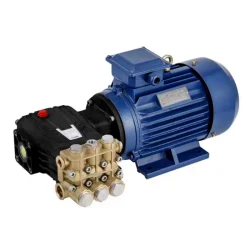What is a Hydrostatic Test Pump?
2024-04-07
A hydrostatic test pump, also known as a hydrostatic pressure test pump, is a specialized device used to test the strength and integrity of pipes, vessels, plumbing systems, and other pressure-containing components. The primary purpose of a hydrostatic test pump is to apply hydraulic pressure to a system or component to verify its ability to withstand the specified pressure without leaking or failing.
Here's how a hydrostatic test pump works and its key features:
1. Hydraulic Pump:
- A hydrostatic test pump typically consists of a hydraulic pump mechanism that generates high-pressure fluid flow. This pump may be powered by manual operation, electric motor, or gasoline engine, depending on the model and application.
2. Pressure Gauge:
- The test pump is equipped with a pressure gauge that measures the hydraulic pressure applied to the system being tested. The pressure gauge allows operators to monitor and control the pressure accurately during the testing process.
3. Hoses and Fittings:
- Hydrostatic test pumps are connected to the system under test via hoses and fittings that allow the pressurized fluid to be transferred from the pump to the test object. These hoses and fittings are designed to withstand high-pressure conditions and ensure a secure connection.
4. Reservoir Tank:
- Some hydrostatic test pumps feature a reservoir tank that holds the fluid (usually water or hydraulic oil) used for pressurizing the system. The reservoir tank ensures a continuous and stable supply of fluid during the testing process.
5. Safety Relief Valve:
- To prevent over-pressurization and ensure operator safety, hydrostatic test pumps are often equipped with a safety relief valve. The relief valve releases excess pressure from the system if it exceeds the set limit, protecting against potential damage or injury.
6. Portability and Mobility:
- Many hydrostatic test pumps are designed to be portable and lightweight, allowing them to be easily transported to different job sites or locations where pressure testing is required. Some models may include handles, wheels, or other features for enhanced mobility and maneuverability.
7. Accuracy and Precision:
- Hydrostatic test pumps are engineered for accuracy and precision in applying and maintaining the desired test pressure. This ensures reliable and consistent results during pressure testing, allowing operators to verify the integrity of the tested components effectively.
Hydrostatic test pumps are commonly used in various industries, including construction, plumbing, oil and gas, manufacturing, and firefighting, for testing pipelines, pressure vessels, boilers, fire suppression systems, and other critical infrastructure components. By subjecting these systems to hydraulic pressure testing, operators can identify potential leaks, weaknesses, or defects and ensure compliance with safety standards and regulations.



